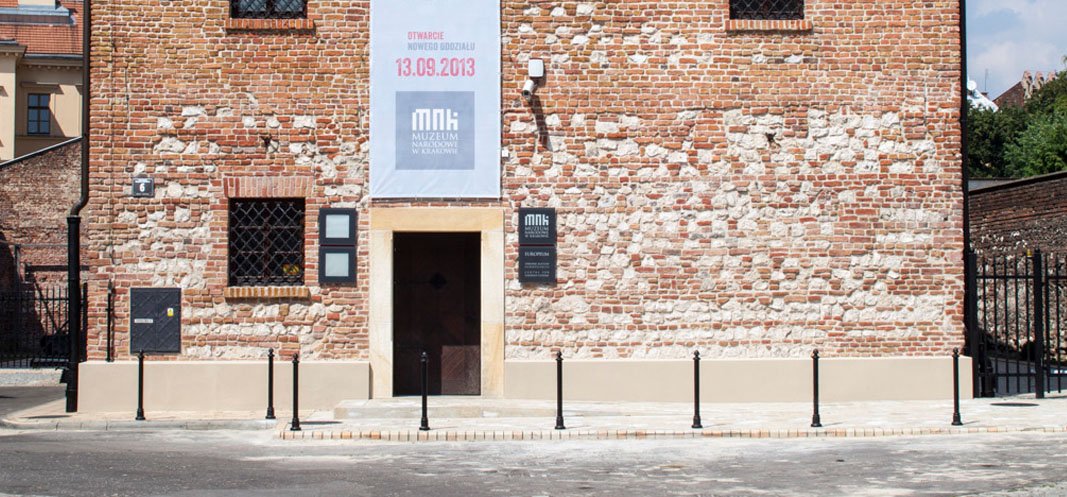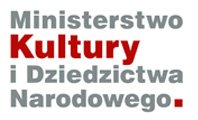Renovation of the historic granary and opening of the EUROPEUM
In September 2013 a new branch of the National Museum in Krakow was opened: EUROPEUM The European Culture Centre, in the historic granary at 6 Sikorskiego Square.
The granary is the oldest building in that area. Its immediate surroundings, what is now Sikorskiego Square, are part of the largest and oldest Krakow noble-owned settlement (jurydyka) known as Garbary (or Piasek), which occupied land acquired by the city from King Kazimierz the Great in 1363. The square itself was laid out in the late nineteenth century on land that was at the time owned by the Jabłonowski dukes. Originally nameless, it officially became known in 1926 as Jabłonowskich Square, and ultimately, in 1948, as Sikorskiego Square. The granary itself, first documented in the eighteenth century, in the nineteenth served functions including that of storehouse for a carriage works. It passed into the MNK’s hands after the war, and until the end of 2007 was used as a store for artworks.
The new exhibition in the restored Granary covers seven centuries of European painting and sculpture, from the fourteenth to the twentieth centuries. Among the exhibits are canvases by Paolo Veneziano, Lorenzo Lotto, Bellini, Strozzi, Magnasco, J.X. Fabre, and Vlamynck. Temporary exhibitions will focus on the links between Polish culture and the wider European culture. Works by Western European artists working for Poles (Thorvaldsen, Canova) will also be on display, as well as portraits of famous Poles in emigration in Paris, including Chopin, Mickiewicz and Krasiński, made by European artists.
There is also an educational room and a computer room, which will be home to the country’s only centre for information on collections of West European painting in Poland. The completed project will also involve adapting the Granary infrastructure to accommodate the needs of disabled people (with a life and toilets), and creating and developing interactive forms of participation in culture suited to the needs of various different groups of users.
In the courtyard behind the Granary a lapidarium has been established, bringing together architectural details from various different buildings across our city – many of them no longer standing. An educational path guides visitors round the lapidarium, offering snippets of information about its various elements.
In the immediate vicinity of the Granary there are numerous historic sites and several other branches of the National Museum in Krakow. For those who enjoy a true cultural experience this area is ideal for a tour of several museums and the art in them without the need to cover long distances. Just a short distance from the Granary is the European Numismatic Centre in the Czapski Palace, and two of the museum’s older branches, the Main Building and the Józef Mehoffer House.
THE PROGRESS OF THE WORK
The restoration and modernisation of the building under the eye of the conservator began in 2009. First of all, the old shacks and outbuildings in the courtyard were taken down and new paving laid. Illumination was installed and greenery and small architectural features added.
By October 2012 the building and finishing work on the final phase of the EUROPEUM building restoration had completed. Next, the electrical and low-power fittings were installed.
A tender for supply of multimedia kiosks and content was conducted and the contract with the supplier signed. An optical fibre connection was laid from the Granary to the building of High School No. 5, where the central hub of the Municipal Computer Network is housed. This enables us to control and monitor from the Main Building the technical installations responsible for the various ambient parameters in the Granary (e.g. the remote operation and monitoring of temperature and humidity gauges in each room, the ice water generator, the leak detection alarm system, and the multimedia system), so significantly reducing overheads.
The technical documentation for the development of the site around the building was compiled and the administrative permit necessary to conduct the work was obtained.
Work on the development of the site was carried out by a contractor selected by tender, and was completed by 15 November 2012.
The next stage (to July 2013) was the furnishing of the building. Furniture custom-designed by architect Jolanta Wodyńska for the display of the exhibits, above all sculptures and paintings, and for visitors, in the entrance area, was made and fitted from funds from the Małopolska Regional Operating Programme. The furniture in areas open to the public is colour-coordinated with the wooden flooring in the main exhibition room, creating a harmonious whole as a foil for the work of art on display.
The attic space of the building, which houses the administration and a small conservator’s atelier, was furnished with office furniture.
The official opening of the EUROPEUM was held on the evening of Thursday, 12 September 2013. The ceremony at the former Jabłonowski family granary was attended by guests including minister Małgorzata Omilanowska, under-secretary of state at the Ministry of Culture and National Heritage, Magdalena Sroka, deputy mayor for culture and promotion of the city, Prof. Franciszek Ziejka, chairman of the Citizens’ Committee for Restoration of Krakow’s Monuments, His Eminence Cardinal Stanisław Dziwisz, Jerzy Miller, voivode of Małopolska, and the consuls of several states and representatives of institutions of higher learning.
This investment was financed from a number of sources, including the National Fund for Revalorisation of Krakow’s Monuments, administered by the Citizens’ Committee for Restoration of Krakow’s Monuments. This grant totalled more than PLN 4.5 million.
Another source of finance was the Małopolska Regional Operating Programme (MRPO), which contributed PLN 2.4 million. The final source of financing for this investment was the “Culture Infrastructure” Programme of the Minister of Culture and National Heritage, which supplied a further PLN 540,000.
These funds were used to develop the site around the building, lay the optical fibre cable, and purchase the multimedia kiosks and software.
The total value of the investment was almost PLN 9 million, and the exact amount sourced from the MRPO PLN 2,399,999.66.
Supplementary finance from funds of the Minister of Culture and National Heritage.
The new exhibition in the restored Granary covers seven centuries of European painting and sculpture, from the fourteenth to the twentieth centuries. Among the exhibits are canvases by Paolo Veneziano, Lorenzo Lotto, Bellini, Strozzi, Magnasco, J.X. Fabre, and Vlamynck. Temporary exhibitions will focus on the links between Polish culture and the wider European culture. Works by Western European artists working for Poles (Thorvaldsen, Canova) will also be on display, as well as portraits of famous Poles in emigration in Paris, including Chopin, Mickiewicz and Krasiński, made by European artists.
There is also an educational room and a computer room, which will be home to the country’s only centre for information on collections of West European painting in Poland. The completed project will also involve adapting the Granary infrastructure to accommodate the needs of disabled people (with a life and toilets), and creating and developing interactive forms of participation in culture suited to the needs of various different groups of users.
In the courtyard behind the Granary a lapidarium has been established, bringing together architectural details from various different buildings across our city – many of them no longer standing. An educational path guides visitors round the lapidarium, offering snippets of information about its various elements.
In the immediate vicinity of the Granary there are numerous historic sites and several other branches of the National Museum in Krakow. For those who enjoy a true cultural experience this area is ideal for a tour of several museums and the art in them without the need to cover long distances. Just a short distance from the Granary is the European Numismatic Centre in the Czapski Palace, and two of the museum’s older branches, the Main Building and the Józef Mehoffer House.
THE PROGRESS OF THE WORK
The restoration and modernisation of the building under the eye of the conservator began in 2009. First of all, the old shacks and outbuildings in the courtyard were taken down and new paving laid. Illumination was installed and greenery and small architectural features added.
By October 2012 the building and finishing work on the final phase of the EUROPEUM building restoration had completed. Next, the electrical and low-power fittings were installed.
A tender for supply of multimedia kiosks and content was conducted and the contract with the supplier signed. An optical fibre connection was laid from the Granary to the building of High School No. 5, where the central hub of the Municipal Computer Network is housed. This enables us to control and monitor from the Main Building the technical installations responsible for the various ambient parameters in the Granary (e.g. the remote operation and monitoring of temperature and humidity gauges in each room, the ice water generator, the leak detection alarm system, and the multimedia system), so significantly reducing overheads.
The technical documentation for the development of the site around the building was compiled and the administrative permit necessary to conduct the work was obtained.
Work on the development of the site was carried out by a contractor selected by tender, and was completed by 15 November 2012.
The next stage (to July 2013) was the furnishing of the building. Furniture custom-designed by architect Jolanta Wodyńska for the display of the exhibits, above all sculptures and paintings, and for visitors, in the entrance area, was made and fitted from funds from the Małopolska Regional Operating Programme. The furniture in areas open to the public is colour-coordinated with the wooden flooring in the main exhibition room, creating a harmonious whole as a foil for the work of art on display.
The attic space of the building, which houses the administration and a small conservator’s atelier, was furnished with office furniture.
The official opening of the EUROPEUM was held on the evening of Thursday, 12 September 2013. The ceremony at the former Jabłonowski family granary was attended by guests including minister Małgorzata Omilanowska, under-secretary of state at the Ministry of Culture and National Heritage, Magdalena Sroka, deputy mayor for culture and promotion of the city, Prof. Franciszek Ziejka, chairman of the Citizens’ Committee for Restoration of Krakow’s Monuments, His Eminence Cardinal Stanisław Dziwisz, Jerzy Miller, voivode of Małopolska, and the consuls of several states and representatives of institutions of higher learning.
This investment was financed from a number of sources, including the National Fund for Revalorisation of Krakow’s Monuments, administered by the Citizens’ Committee for Restoration of Krakow’s Monuments. This grant totalled more than PLN 4.5 million.
Another source of finance was the Małopolska Regional Operating Programme (MRPO), which contributed PLN 2.4 million. The final source of financing for this investment was the “Culture Infrastructure” Programme of the Minister of Culture and National Heritage, which supplied a further PLN 540,000.
These funds were used to develop the site around the building, lay the optical fibre cable, and purchase the multimedia kiosks and software.
The total value of the investment was almost PLN 9 million, and the exact amount sourced from the MRPO PLN 2,399,999.66.
Supplementary finance from funds of the Minister of Culture and National Heritage.


